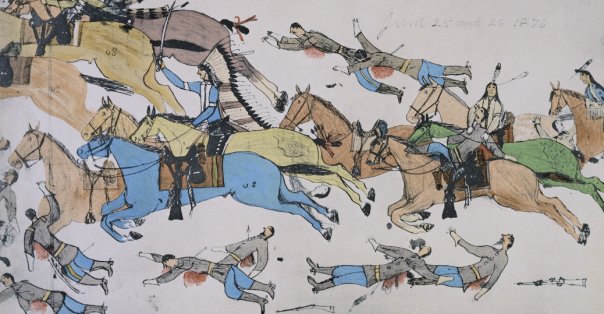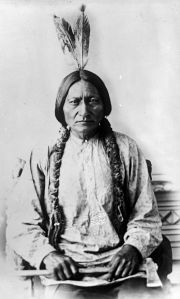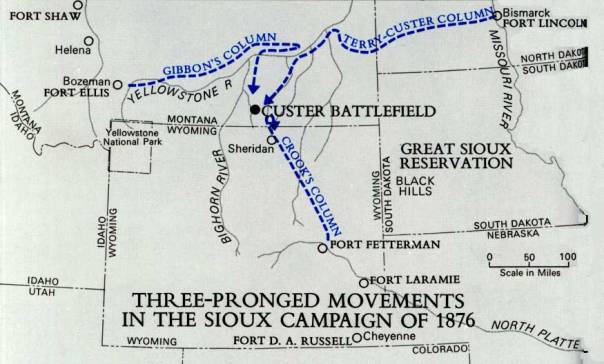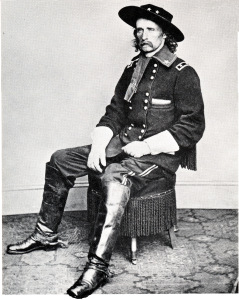Filed under: Analysis, Indigenous, US

From Warrior Publications
by Zig Zag
On June 25, 1876, the US Army’s 7th Calvary Regiment under the command of Lt-Colonel Custer attempted to attack a large encampment of several thousand northern plains Natives, including Lakota, Cheyenne, and Arapaho, along a small river in present-day eastern Montana. Today it is commonly known as the Battle of the Little Big Horn. To the Native people’s who participated it was known as the Battle of the Greasy Grass.
At the time, the US was expanding westward and sought to confine Indigenous peoples to reservations in order to take their land for settlement and resources. When gold was discovered in the Black Hills the federal government began planning a campaign to bring in Natives who refused to go to the reservations established under the 1868 Fort Laramie Treaty. Sitting Bull, a respected military and spiritual leader of the Hunkpapa Lakota, had refused the treaty and reservations. He and others continued to move and hunt with the buffalo herds, carrying out sporadic attacks on settlers and railway surveyors. These Natives were referred to as “hostiles.”

Sitting Bull, Hunkpapa Lakota.
The government established a deadline of January 1876 for all “hostiles” to return to the reservations, knowing it would be almost impossible for Natives to travel in the dead of winter to meet the deadline. In May, 1876, three separate columns of cavalry and infantry were deployed with the intention of marching to the Upper Yellowstone River, an area where the “hostiles” were expected to be gathering at that time of year. Their mission was to destroy the military capacity of the Natives and force the survivors onto the reservations.
Primarily through the influence of Sitting Bull, as many as 7-8,000 people had joined together in one of the largest gathering of northern plains nations at the time along the Little Big Horn River. It was around 3 miles long and a half mile wide. An estimated 2,000 warriors were in the camp, ready to fight after being pressured by colonial forces and experiencing several massacres.
“If he is in superior strength, evade him… If equally matched, we can offer battle; if slightly inferior in numbers, we can avoid the enemy; if quite unequal in every way, we can flee from him… Hence, though an obstinate fight may be made by a small force, in the end it must be captured by the larger force…
“He who exercises no forethought but makes light of his opponents is sure to be captured by them… To begin by bluster, but afterwards to take fright at the enemy’s numbers, shows a supreme lack of intelligence. ”
Sun Tzu, The Art of War
One of the most common causes of military defeats is underestimating the enemy’s size, fighting skills, or determination. In the case of Lt-Colonel Custer, he was both arrogant and extremely racist, believing that Native peoples would run at the first sight of his 7th Cavalry. It was in fact a common belief among cavalry officers that plains Natives were not good fighters and would run rather than stand and fight. The only question was how to catch them, irregardless of numbers.
When the large encampment of Natives was found on June 25, Custer divided his forces, sending a detachment of some 150 men under Captain Benteen to hills south-west of the camp in order to prevent the Natives escaping in that direction. His greatest concern was that the Natives would scatter into numerous smaller groups, thereby depriving him of the ability to strike a decisive blow and bring the campaign to an end. Yet another group of troopers were assigned to guard the pack mules and supplies. Despite being told of the massive size of the camp, he proceeded with the attack.
As Custer’s column approached the camp he saw dust rising and believed that the Natives were indeed scattering. He hastily sent another detachment under Major Reno to attack the south of the camp, promising to support him. Now his force was divided into three separate groups. Custer took the remainder of the column, some 200 men, to bluffs north of the camp, where he intended to attack.
When he finally saw the full extent of the camp, Custer reportedly turned white, but then took off his hat and waved it in the air, declaring to his troops: “Hurrah boys! We’ve got them! We’ll finish them up, and then go home to our station!” He sent a runner to Benteen, ordering him to join in the attack.
Meanwhile, Major Reno and his detachment of some 140 troopers were riding along the Little Big Horn River towards the camp. He still had not actually seen the camp, until he turned a bend in the river. Already warriors were riding out to meet him. Believing Custer had sent him into an ambush, Reno stopped and had his troopers dismount and form a skirmishing line. But as more warriors joined in the attack, Reno began a chaotic retreat that saw many of his troopers die as they desperately tried to escape. Reno and the remainder of his troop would later link up with Benteen, but instead of going to Custer’s aid they stopped and waited for an hour and a half, believing Custer had retreated in the face of such overwhelming odds (and believing that Custer had abandoned them as he did a company during the Washita Creek massacre in November, 1868; the entire company had been killed).
Custer’s force of 200 troopers were no match for nearly 2,000 warriors, who swarmed out of the camp and within the span of two hours or so had completely annihilated his force. Benteen and Reno’s combined force retreated to a defensible position and held off warrior attacks for 36 hours, ending only when the Native encampment packed up and moved south.
“Whoever is first in the field and awaits the coming of the enemy, will be fresh for the fight; whoever is second in the field and has to hasten to battle will arrive exhausted.”
Sun Tzu, The Art of War
The 1876 campaign against the plains nations saw 3 separate columns of cavalry and infantry deployed from three separate locations which were to converge in the Upper Yellowstone River area where it was expected the “hostiles” would be gathered.

Brig. Gen. Alfred Terry’s column, with 1200 soldiers including twelve companies of the 7th Cavalry under Lt-Colonel George Armstrong Custer’s immediate command, departed westward from Fort Abraham Lincoln in the Dakota Territory on May 17. The column averaged nearly 30 miles (48 km) a day. Custer planned “to live and travel like Indians; in this manner the command will be able to go wherever the Indians can,” he wrote in his Herald dispatch.
Another column under Colonel Gibbon marched east from Fort Ellis in the Montana Territory with 440 soldiers, while General Crook marched north from Fort Fetterman in the Wyoming Territory with 1100 soldiers.
On June 21 a detachment from the Terry-Custer column located the trail of the “hostiles.” General Terry split his force, sending Custer to follow the trail while he was to take the remaining force west along the Yellowstone River and then south along the Big Horn River, where the camp was suspected to be.
If Custer’s force arrived at the encampment first he was ordered to wait for Terry’s column, but historians believe that Terry knew Custer would not wait and would attack the camp immediately upon finding it. If successful, Terry would take credit; if unsuccessful, Custer would take responsibility as he would have to disobey an order to carry out an attack.
Setting off with some 650 troopers under his command on June 22, Custer was determined to catch the Natives and deliver a decisive blow. An ambitious man, Custer sought fame and glory and knew that this campaign would likely be one of the last major military operations of his career. He pushed his column hard to catch up with the Natives, marching all through the night on June 24 until his troops neared collapse. By the time they reached the large encampment of Natives on June 25, the day of the battle, they and their horses were exhausted. When the fighting started, Custer’s forces faced a large number of warriors with high energy and fresh horses.
“When there are murmurings, lapses in duties, and extended conversations, the loyalty of the group has been lost.”
Sun Tzu, The Art of War
As noted previously, when Custer’s detachment came under attack, Major Reno and Captain Benteen, after linking up following Reno’s chaotic retreat, sat and waited for an hour and a half. They discussed their misgivings about Custer at length, and assumed that he had most likely retreated and in fact abandoned them in the face of overwhelming force. This belief stemmed from Custer’s actions during the massacre at Washita Creek.

Lt-Colonel George Armstrong Custer.
On November 27, 1868, in present-day Oklahoma, Custer had attacked a village of peaceful Cheyenne led by Black Kettle. Very few warriors were in the camp, and the cavalry killed some 103 people, mostly elders, women and children. Further down the Washita River, however, was a much larger village with many more warriors, who began moving towards Custer’s forces and threatening to surround it.
Custer placed a large group of prisoners—women and children—in the front of his column and began marching towards the village from which the warriors had come. Seeing this, the warriors returned to their village in order to defend it. Custer then reversed course and managed to escape a more dangerous confrontation.
Before this, however, Major Ellis, with a company of some 20 troopers, had taken off in pursuit of a small group of Cheyenne warriors. Because night was falling, and fearing the large numbers of warriors in the vicinity, Custer had departed without making any effort to locate Ellis’ troopers. The entire group was later found many days later, all dead.
Captain Benteen, Major Reno, and some of the other officers saw this as a betrayal, viewing Custer as a glory-seeking and reckless fool. During the Little Big Horn battle, both Reno and Benteen assumed Custer had abandoned them as he had Major Ellis, and made no effort to locate him or go to his aid.
“There are five dangerous faults which may affect a general: (1) Recklessness, which leads to destruction; (2) cowardice, which leads to capture; (3) a hasty temper, which can be provoked by insults; (4) a delicacy of honour which is sensitive to shame; (5) over-solicitude for his men, which exposes him to worry and trouble.
These are the five besetting sins of a general, ruinous to the conduct of war.
When an army is overthrown and its leader slain, the cause will surely be found among these five dangerous faults. Let them be a subject of meditation.”
Sun Tzu, The Art of War
When Custer ordered the attack on the Native village at the Little Big Horn, he didn’t carry out any reconnaissance to learn the size of the village and how many warriors might be expected. He ordered Major Reno to begin an attack without having actually seen the encampment out of fear that the Natives would scatter.
Custer was not necessarily a coward. In fact, it was his daring exploits during the US Civil War, where he led his troopers from the front, that had made him a celebrity of sorts. He was, however, ambitious and overly concerned about his public image, seeking ever greater glories on the battlefield (a “delicacy of honour”).![]()





